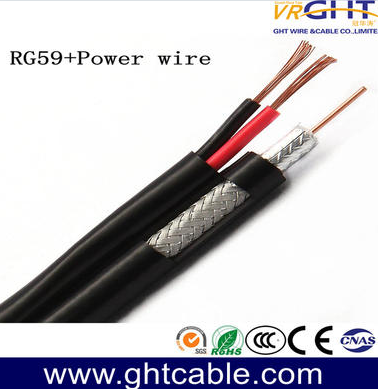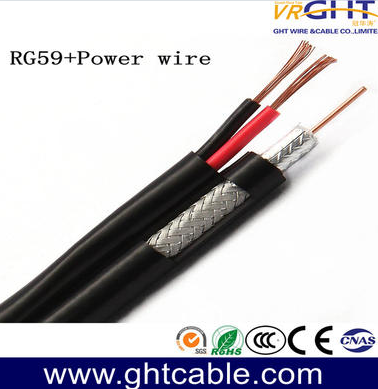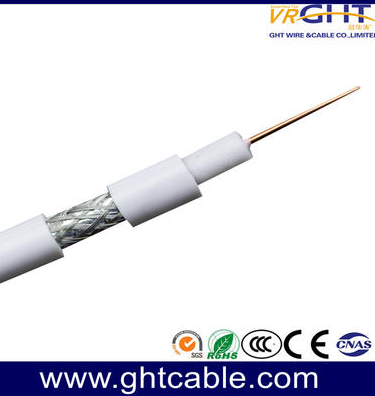
ما هي استخدامات الكابل المحوري؟
في شبكة الاتصالات الحديثة المعقدة، يلعب بطل مجهول دورًا حاسمًا - الكابلات المحورية. هذه الكابلات هي الناقلات الصامتة لإشارات الصوت والفيديو والبيانات، وتنسج الاتصالات التي تغذي أنظمة الترفيه وخدمات الإنترنت وشبكات الأمان. في هذا المنشور، سيرشدك المؤلف لاستكشاف الكابلات المحورية.
ما هو الكابل المحوري؟
في الأساس، يعد الكابل المحوري كابلًا كهربائيًا متخصصًا مصممًا بموصل مركزي، محاط بطبقة عازلة ودرع معدني وطبقة عازلة خارجية. يوفر هذا التصميم الفريد قدرات نقل إشارة محسنة، مما يجعل الكابلات المحورية عنصرًا أساسيًا في أنظمة الاتصالات المختلفة.
ما هي استخدامات الكابل المحوري؟
تجد الكابلات المحورية تطبيقات متعددة في مختلف الصناعات نظرًا لتصميمها وقدراتها الفريدة. وفيما يلي بعض الاستخدامات الشائعة للكابلات المحورية:
●البث التلفزيوني
تُستخدم الكابلات المحورية على نطاق واسع لنقل إشارات التلفزيون من موفري الكابلات أو الأقمار الصناعية إلى المنازل. وتحظى الكابلات المحورية RG6، على وجه الخصوص، بشعبية كبيرة في هذا التطبيق.
●الاتصال بالإنترنت
تلعب الكابلات المحورية دورًا حاسمًا في توفير اتصال إنترنت عالي السرعة. يستخدم مزودو خدمة الإنترنت عبر الكابلات الكابلات المحورية لتقديم خدمات الإنترنت ذات النطاق العريض للمنازل والشركات.
●شبكات الهاتف
تستخدم بعض شبكات الهاتف الكابلات المحورية لنقل الإشارات الصوتية. وفي حين أصبحت الألياف الضوئية والتقنيات الأخرى أكثر انتشارًا، لا تزال الكابلات المحورية مستخدمة في أنظمة هاتفية معينة.
●الدوائر التلفزيونية المغلقة (CCTV)
تُستخدم الكابلات المحورية بشكل شائع في أنظمة CCTV لنقل إشارات الفيديو من كاميرات المراقبة إلى معدات المراقبة. تساعد الحماية الموجودة في الكابلات المحورية على تقليل التداخل وضمان نقل الفيديو بوضوح.
●شبكات البيانات
تُستخدم الكابلات المحورية، وخاصة تلك ذات المواصفات الأعلى مثل RG58 وRG8، في تطبيقات شبكات البيانات. ويمكنها نقل البيانات بسرعات عالية وهي مناسبة لاتصالات Ethernet معينة.
●تطبيقات الترددات الراديوية (RF)
تُستخدم الكابلات المحورية على نطاق واسع في تطبيقات التردد اللاسلكي، مثل توصيل الهوائيات بأجهزة الراديو أو التلفزيون. وهي توفر وسطًا مستقرًا وفعالًا لنقل إشارات التردد اللاسلكي.
●التطبيقات العسكرية والفضائية
تُستخدم الكابلات المحورية في التطبيقات العسكرية والفضائية لأنظمة الاتصالات وأنظمة الرادار وغيرها من المعدات الإلكترونية. إن متانتها وقدرتها على نقل الإشارات لمسافات طويلة تجعلها مناسبة لهذه التطبيقات الحرجة.
●معدات التصوير الطبي
تُستخدم الكابلات المحورية في معدات التصوير الطبي، مثل أجهزة التصوير بالرنين المغناطيسي والتصوير المقطعي المحوسب، لنقل الإشارات بين المكونات. تساعد الحماية الموجودة في الكابلات المحورية في منع التداخل في الأجهزة الطبية الحساسة.
●شبكات إيثرنت في التثبيتات القديمة
في بعض تركيبات الشبكات القديمة، كانت الكابلات المحورية تُستخدم لاتصالات Ethernet قبل التبني الواسع النطاق لكابلات الزوج الملتوي. ورغم أنها أقل شيوعًا اليوم، إلا أنها لا تزال موجودة في بعض الأنظمة القديمة.
●راديو الهواة (راديو الهواة)
تُستخدم الكابلات المحورية على نطاق واسع في إعدادات الراديو للهواة لإرسال واستقبال الإشارات. وهي ذات قيمة لقدرتها على حمل إشارات التردد اللاسلكي بكفاءة.
ما هي إيجابيات الكابل المحوري؟
تتمتع الكابلات المحورية بالعديد من المزايا التي تجعلها مناسبة لتطبيقات مختلفة. فيما يلي بعض مزايا الكابلات المحورية:
●تخفيف الإشارة المنخفضة
تتميز الكابلات المحورية بضعف الإشارة، مما يعني أن قوة الإشارة تظل مستقرة نسبيًا على مسافات أطول. وهذا أمر بالغ الأهمية للتطبيقات التي تتطلب جودة إشارة ثابتة وموثوقة، مثل خدمات التلفزيون عبر الكابل والإنترنت عريض النطاق.
●عزل الإشارة
يوفر البناء الطبقي للكابلات المحورية عزلًا فعالًا للإشارات. يساعد هذا العزل في منع تسرب الإشارة والتداخل، مما يضمن أن كل كابل يحمل الإشارات المقصودة دون تداخل من الكابلات المجاورة أو المصادر الخارجية. وهذا مفيد بشكل خاص في المناطق ذات الكثافة السكانية العالية حيث قد تكون هناك كابلات متعددة تعمل على مقربة من بعضها البعض.
●الحصانة ضد التداخل الكهرومغناطيسي (EMI)
يعمل الدرع المعدني المحيط بالموصل المركزي كحاجز يحمي الإشارة من التداخل الكهرومغناطيسي الخارجي. تعد هذه الميزة ضرورية في البيئات التي قد توجد بها أجهزة إلكترونية أو مصادر أخرى للإشعاع الكهرومغناطيسي، مما يضمن نقل إشارة مستقر وخالٍ من التداخل.
●الأمن
توفر الكابلات المحورية مستوى من الأمان بسبب تصميمها المحمي. لا توفر الطبقة المعدنية الخارجية الحماية من التداخل فحسب، بل تجعل أيضًا من الصعب الوصول غير المصرح به إلى الإشارات المرسلة. يمكن أن يكون هذا مفيدًا في التطبيقات حيث يكون أمان البيانات أولوية، مثل أنظمة التلفزيون ذات الدائرة المغلقة (CCTV).
●التوافق مع البنية التحتية الحالية
تتمتع الكابلات المحورية بالتوافق مع العديد من الأنظمة والبنية الأساسية الحالية. وهذا يجعلها خيارًا عمليًا لترقية الشبكات أو توسيعها دون الحاجة إلى إصلاح كامل للإعداد الحالي.
●التواصل ثنائي الاتجاه
يمكن أن تدعم الكابلات المحورية الاتصالات ثنائية الاتجاه، مما يسمح بنقل واستقبال الإشارات في وقت واحد. هذه الميزة مفيدة في تطبيقات مثل خدمات الإنترنت عبر الكابلات ثنائية الاتجاه ومؤتمرات الفيديو.
●سهولة الصيانة
تعتبر الكابلات المحورية سهلة الصيانة واستكشاف الأخطاء وإصلاحها نسبيًا. تعمل الموصلات المعيارية المستخدمة مع الكابلات المحورية على تبسيط عملية تحديد المشكلات وحلها، مما يقلل من وقت التوقف وتكاليف الصيانة.
خاتمة
بشكل عام، تمتد مزايا الكابلات المحورية إلى ما هو أبعد من سماتها الأساسية، لتشمل عوامل مثل سلامة الإشارة والأمان والتوافق. تساهم هذه الصفات في الاستخدام الواسع النطاق للكابلات المحورية في أنظمة الاتصالات والنقل المتنوعة. تظل الكابلات المحورية عنصرًا أساسيًا في عالمنا المترابط.









اترك تعليقا